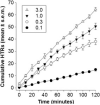Head-twitch response in rodents induced by the hallucinogen 2,5-dimethoxy-4-iodoamphetamine: a comprehensive history, a re-evaluation of mechanisms, and its utility as a model
- PMID: 22517680
- PMCID: PMC3722587
- DOI: 10.1002/dta.1333
Head-twitch response in rodents induced by the hallucinogen 2,5-dimethoxy-4-iodoamphetamine: a comprehensive history, a re-evaluation of mechanisms, and its utility as a model
Abstract
Two primary animal models persist for assessing hallucinogenic potential of novel compounds and for examining the pharmacological and neurobiological substrates underlying the actions of classical hallucinogens, the two-lever drug discrimination procedure and the drug-induced head-twitch response (HTR) in rodents. The substituted amphetamine hallucinogen, serotonin 2 (5-HT(2) ) receptor agonist, 2,5-dimethoxy-4-iodoamphetamine (DOI) has emerged as the most popular pharmacological tool used in HTR studies of hallucinogens. Synthesizing classic, recent, and relatively overlooked findings, addressing ostensibly conflicting observations, and considering contemporary theories in receptor and behavioural pharmacology, this review provides an up-to-date and comprehensive synopsis of DOI and the HTR model, from neural mechanisms to utility for understanding psychiatric diseases. Also presented is support for the argument that, although both the two-lever drug discrimination and the HTR models in rodents are useful for uncovering receptors, interacting proteins, intracellular signalling pathways, and neurochemical processes affected by DOI and related classical hallucinogens, results from both models suggest they are not reporting hallucinogenic experiences in animals.
Copyright © 2012 John Wiley & Sons, Ltd.
Figures


References
-
- Shannon M, Battaglia G, Glennon RA, Titeler M. 5-HT1 and 5-HT2 binding properties of derivatives of the hallucinogen 1-(2,5-dimethoxyphenyl)-2-aminopropane (2,5-DMA). Eur. J. Pharmacol. 1984;102:23. - PubMed
-
- Knight AR, Misra A, Quirk K, Benwell K, Revell D, Kennett G, Bickerdike M. Pharmacological characterisation of the agonist radio-ligand binding site of 5-HT(2A), 5-HT(2B) and 5-HT(2C) receptors. N-S. Arch. Pharmacol. 2004;370:114. - PubMed
-
- Darmani NA, Martin BR, Pandey U, Glennon RA. Pharmacological characterization of ear-scratch response in mice as a behavioral model for selective 5-HT2-receptor agonists and evidence for 5-HT1B- and 5-HT2-receptor interactions. Pharmacol. Biochem. Be. 1990;37:95. - PubMed
-
- Glennon RA, Young R, Benington F, Morin RD. Behavioral and serotonin receptor properties of 4-substituted derivatives of the hallucinogen 1-(2,5-dimethoxyphenyl)-2-aminopropane. J. Med. Chem. 1982;25:1163. - PubMed
Publication types
MeSH terms
Substances
Grants and funding
LinkOut - more resources
Full Text Sources
Other Literature Sources

